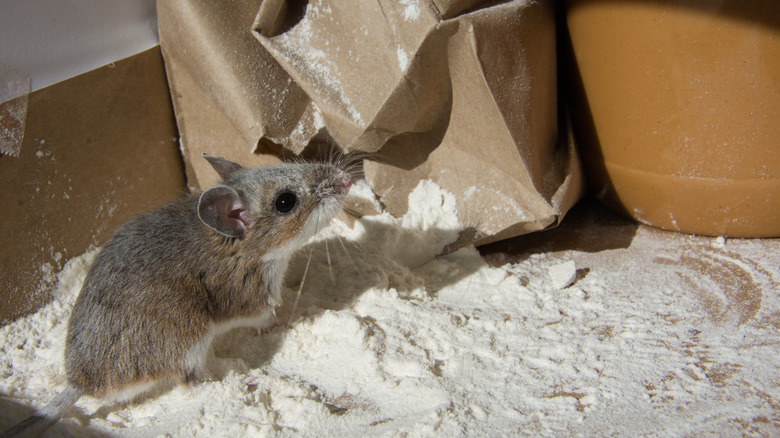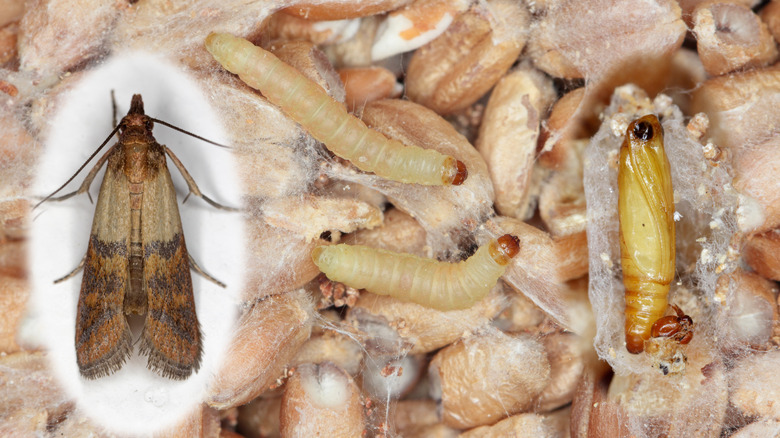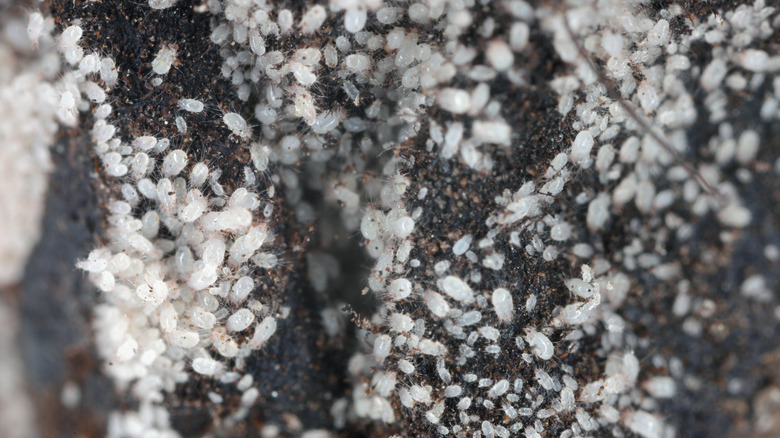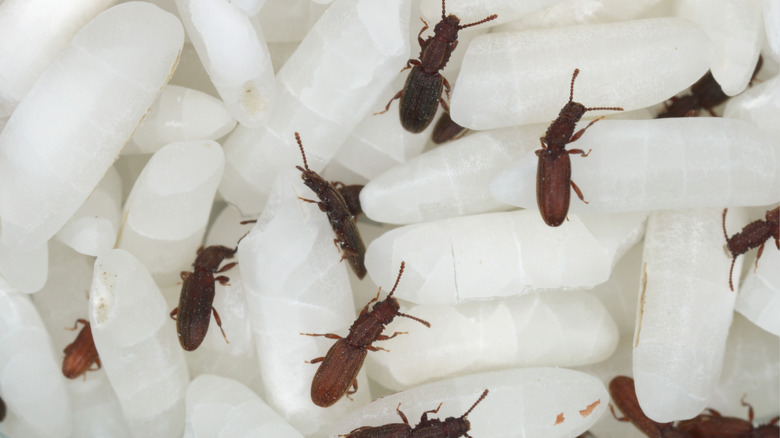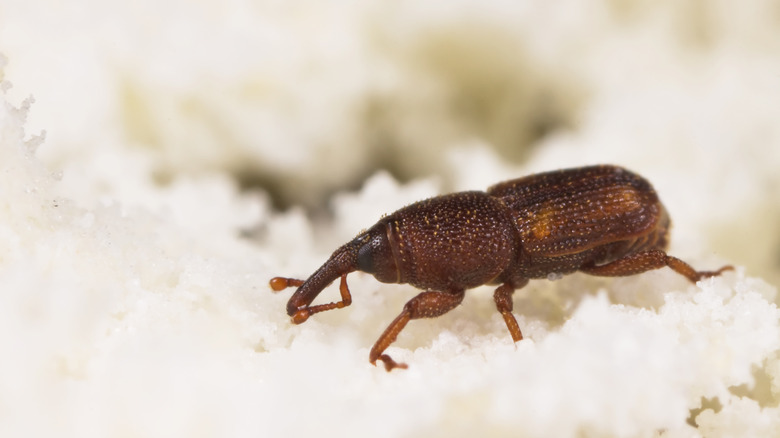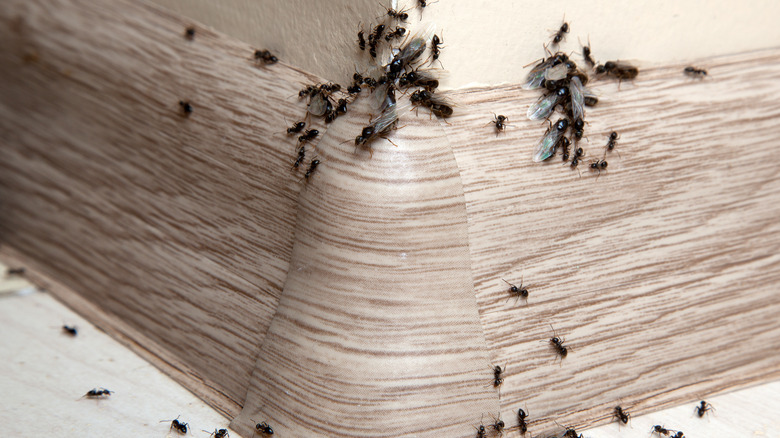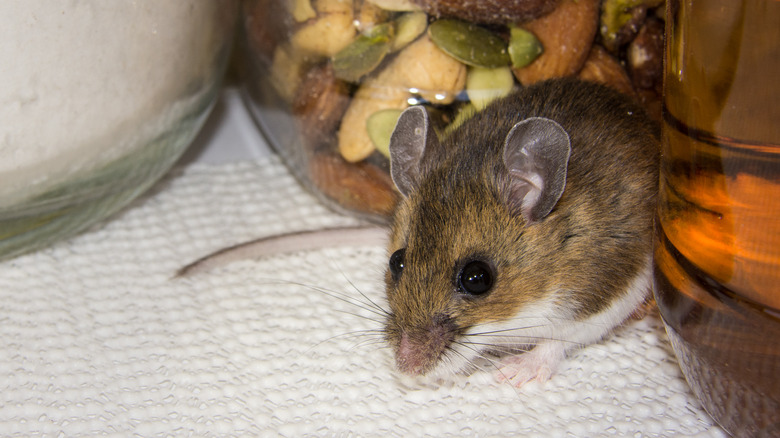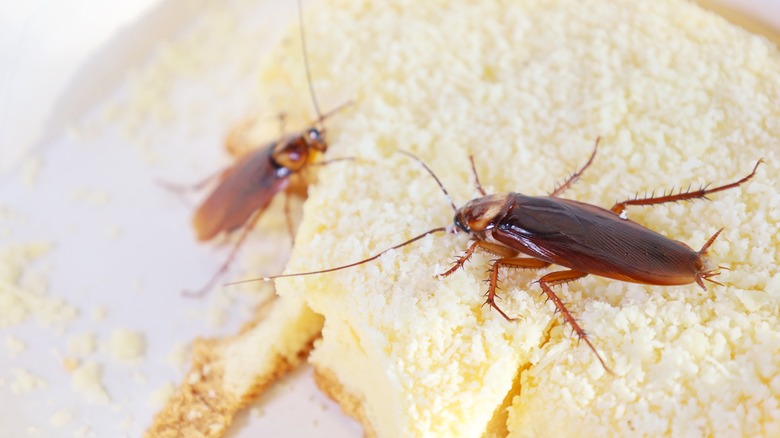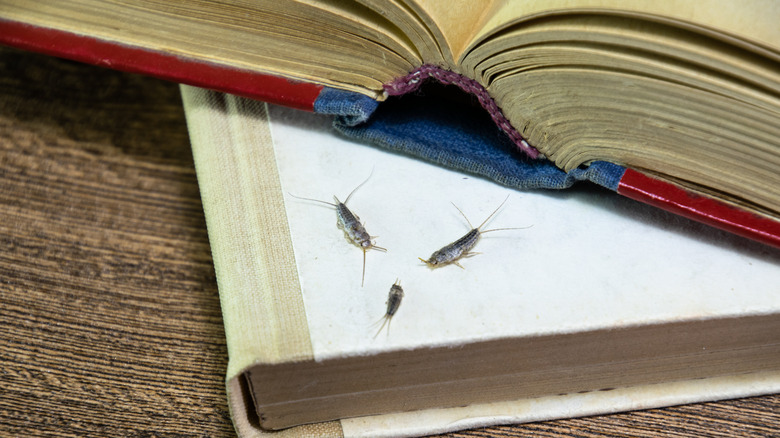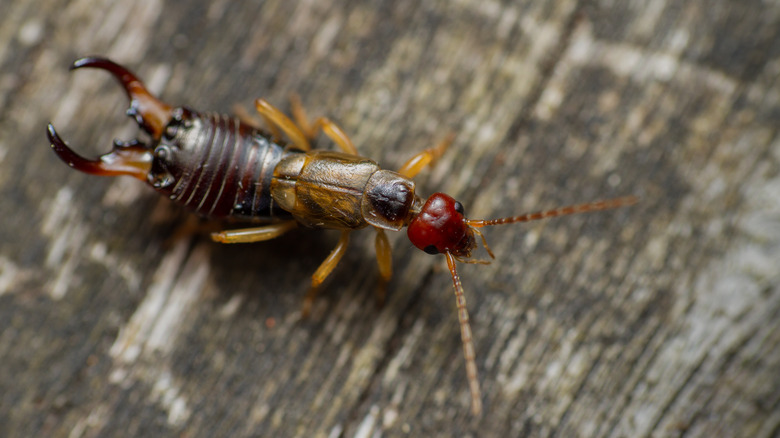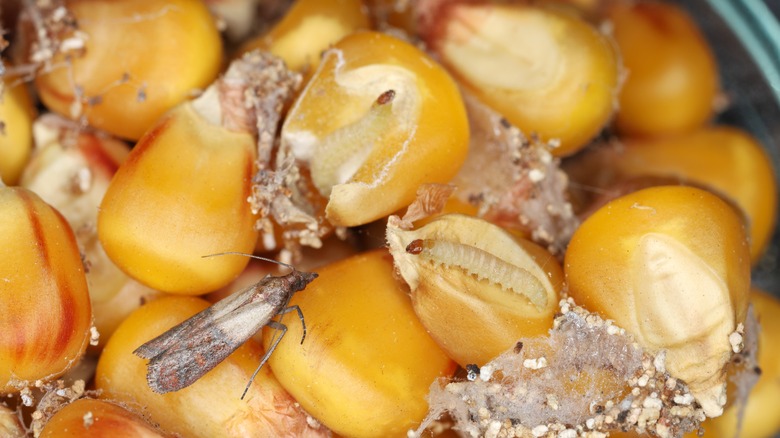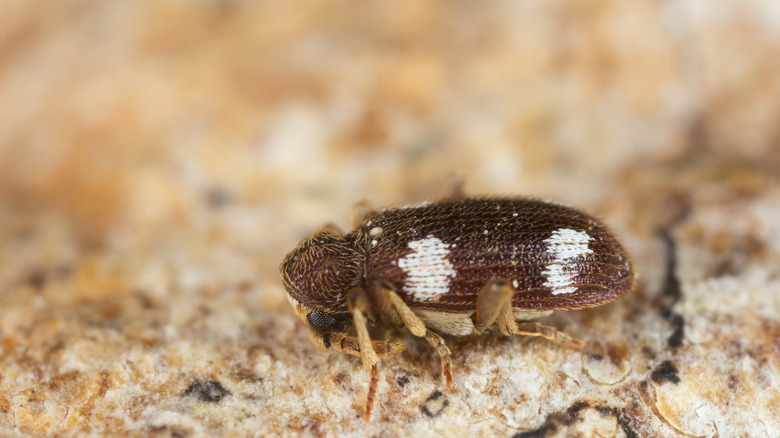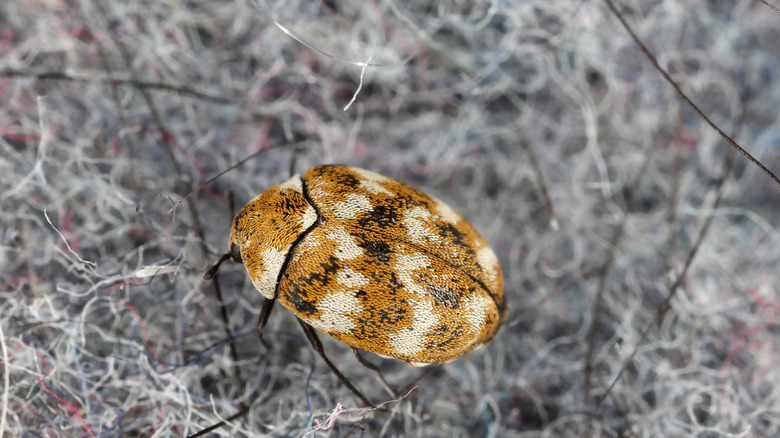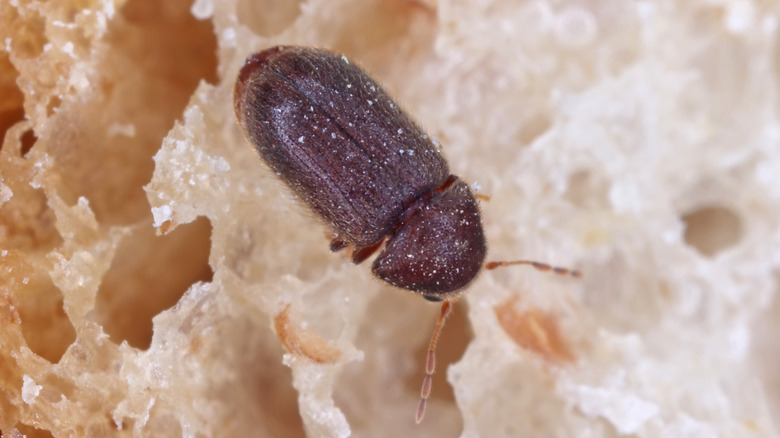Pantry Pests To Be On The Look Out For And How To Deter Them From Invading
The pantry is an essential space in your kitchen, storing various components that help elevate your meals. But, hiding on the shelves, an unseen threat may be ready to feast on whatever you have stored. Pantry pests range from sneaky moth larvae to flour mites, and they will destroy your pantry staples, usually before you know you have a problem. Prevention is the goal with these pests, so you have to learn how to spot the signs that they're lurking around your pantry.
Instead of doing a quick onceover of your pantry, you need to get ahead of the infestation before it takes hold. Understanding what attracts these pests is half the battle, whether it's the starches that draw silverfish or the grains that lure in spider beetles. The other half of the solution is getting deterrents for specific pests, from sealing your food in safe, airtight containers to adding natural repellents.
Be aware that general cleaning tips may not deter these pantry pests because warding them off is about more than keeping the space neat and tidy. It also includes a strategic defense to protect your stored items. The goal is to eliminate infestations and prevent them from returning to safeguard your pantry and food items.
Indian meal moths eat a range of foods
Indian meal moths are pests in your pantry and kitchen, eating a range of dry food items. They love flour, grains, dried nuts, and dried fruits, but they'll also go after candies, chocolates, spices, and pet food. They have a way of slipping through the smallest openings, and they lay eggs in your items. When the eggs hatch, larvae feed on the food and contaminate it with their webbing and excrement, making it unsafe to eat. These moths have a strong sense of smell that guides them to their preferred food sources.
To get rid of an infestation, throw away any contaminated materials and thoroughly clean the whole pantry. The key to deterring these moths from returning is to make your pantry uninviting. Storing your food in airtight metal, glass, or thick plastic containers helps prevent the moths from smelling and getting to the food sources. The materials are too tough for the moths to chew through as well. Regularly clean your pantry shelves, and pay special attention when you vacuum crevices and corners to remove moth eggs. This eliminates potential nesting sites and stops the moth life cycle from continuing.
Flour mites give off a distinct odor
Flour mites target your pantry's cake mixes, flour, grains, and similar products. These mites love items that have had moisture exposure because dampness gives them a solid breeding ground and encourages mold growth, which they eat. Flour mites can quickly infest boxes of grain products or bags of flour, and it's easy to miss them because of their size. They cause food to spoil and contaminate your pantry staples with allergens, making it unsafe to eat. They also produce a very musky odor, a common reason many people discover an infestation.
To get rid of flour mites and protect your pantry, make the space less hospitable for them. Store your cake mixes, flour, and grains in airtight containers with tight lids. The containers should be metal or glass to keep them out. Ensuring your pantry is dry is another crucial step because these pests thrive in damp conditions. Dehumidifiers around the pantry space keep the humidity levels low, making it difficult for them to breed. Checking your pantry for signs of flour mites helps catch them early to head off an infestation. If any items have flour mite signs, remove them to stop them from spreading to other food. Also, you can wipe your pantry with hot, soapy water to kill the eggs and mites on contact.
Saw-toothed grain beetles love starchy foods
Saw-toothed grain beetles are tiny, brown insects that eat grain-based products. The name comes from the saw-like projections on each side of their thorax. They love to eat pasta, cereals, bread, and similar foodstuffs, and they have a talent for getting into and through different packaging. They can get into the smallest cracks in poorly sealed packages, making many of your dried goods vulnerable. They're drawn to high-starch foods because they feed adult beetles and larvae.
The best way to prevent these pests from taking over the pantry is to store your items in airtight metal or glass containers with secure lids to keep the beetles out. Every week or two, inspect your items, looking for beetles or small holes in the packaging. Also, keeping your pantry organized and clutter-free is critical to monitoring and managing your food storage. Check the expiration dates and eliminate old or unused items to deter beetles. If they're already there, remove affected food and store whatever is left in heavy-duty containers. You can also try putting infested food in the oven at 135 degrees Fahrenheit for an hour or in the freezer for six days to kill all stages of the beetle's life cycle before discarding to ensure they don't start the infestation anew.
Rice and grain weevils lay eggs on food
Rice and grain weevils are small, dark brown beetles that love rice, whole grains, nuts, corn, seeds, and beans. These pests are a big problem because they lay eggs inside the grains, and the larvae grow inside, eating the kernel from the inside out. This makes it challenging to find and stop early. While the food is a big draw, weevils also like the pantry because it offers an excellent environment to lay eggs and support the larvae.
You need a preventative and proactive approach to deter rice and grain weevils. One of the best strategies is to freeze any foods they like for at least four days after you bring them home to kill any eggs already in the food. Transfer the food to hard, airtight containers to reduce the risk of issues. Also, routinely clean and organize your pantry while watching for these pests so that you can catch infestations early. In addition, try keeping your pantry cool and dry, as weevils prefer high humidity levels, which makes them reproduce more quickly.
You can also kick pantry weevils to the curb with a few items you already have on hand.
Ants are equal-opportunity pantry pests
Ants invade homes looking for sweets, proteins, and fats, and they have a very strong sense of smell that lets them find the smallest crumbs and residues. They leave a chemical trail for other ants to follow, quickly causing a large infestation. They eat a lot of different things, and this makes your pantry a huge target. Access to items to forage — like sugary snacks, oily foods, and meat products — increases your chances of developing an ant problem. Also, their small size allows them to slip through tiny openings.
To deter and get rid of ants, creating barriers and cleaning the pantry is vital. Regularly wipe down your kitchen and pantry surfaces to eliminate spills and food residue, and store your food in sealed containers. Seal entry points — like the cracks around doorways, baseboards, and doors — with caulk, to make it harder for them to get into your home. Adding peppermint oil or vinegar as natural deterrents around your home wards away ants by interfering with their scent trails. This makes it more difficult for them to find the food sources in your pantry.
Rodents can harbor disease
Rodents are attracted to areas with easy food access, and they'll eat a broad range of foodstuffs, including fruits, cereals, grains, and pet food. Their strong, sharp teeth help them chew through cardboard boxes, plastic bags, concrete, aluminum, softer metals, soft rubber, cloth, paper, and even lead pipe to get to food. Rodents also like areas that offer warmth, shelter, and nesting materials, making homes ideal. Once inside, they damage food supplies and household structures, and pose health risks by spreading diseases in their droppings.
You must take steps to remove their access to shelter and food. Store all your pantry food in rodent-proof containers made of heavy-duty plastic with very tight-fitting lids to keep them from chewing through. Keeping your pantry space clean and clutter-free, sweeping the floors, wiping down surfaces, and removing garbage are all critical. Eliminating clutter will remove potential hiding and nesting spots, making the space less appealing. Seal holes, cracks, or openings that rodents can slip through, and humanely get rid of any mice you already have.
Cockroaches present a health hazard
Cockroaches are omnivorous pests with diets that include sweets, starches, meats, and greasy items, making pantries and kitchens ideal areas to infest. They're opportunistic feeders that will go after almost anything edible (or anything containing food), including unsealed food packages, crumbs on the counters or floors, spills, dirty dishes, or pet food. Once cockroaches find a reliable food source, it's a persistent problem, and their adaptability and resilience mean they can survive various environments. However, they favor humid, warm conditions. Food availability plays a massive role in supporting the colonies, making managing your food sources critical to deterring them.
To keep cockroaches out, a first step is getting rid of their food sources by storing your food in airtight containers. Vacuuming, sweeping, and wiping down your counters and shelves to remove spills and crumbs is essential, as is removing garbage and using sealed garbage cans to make the space less appealing to them. Use traps in kitchens or pantries where you spot cockroaches, and monitor the infestation size. Boric acid is a deterrent for more persistent issues because it acts like a poison. However, keep it away from pets and kids because of the caustic and poisonous nature. Finally, seal any openings or cracks around your cabinets, walls, and pantries to keep cockroaches out.
Silverfish like warm environments
Silverfish are small, wingless insects that love starches, vegetables, grains, and fiber. Their diet includes the glue from bookbinding or packaging, coffee, and sugar. This means finding them in pantries, kitchens, and storage areas is common. Silverfish love environments that have their specific food source, making it a common pest in commercial and residential properties. Along with starches, they eat carbohydrate-rich materials, including cotton, paper, and linen, which can cause clothing and book damage. They are active at night and like moist, dark environments, making them hard to spot and allowing infestations to take hold.
Deterring silverfish means you should reduce how much access they have to their preferred food sources and change the environment to make it less welcoming. Store your dry goods — like coffee, sugar, and flour — in airtight containers. Managing your home's humidity levels is also important to make the space less attractive. Use fans or dehumidifiers to lower the humidity levels and reduce moisture, and regularly look for signs of silverfish. These include silver, fish-like scales, or package damage. To get rid of silverfish, buy sticky traps, clear out old books, seal cracks, or put cedar oil in the pantry.
Earwigs are nocturnal pantry pests
Earwigs are dark, tiny insects that thrive in humid environments. They try to find dark cracks and spaces where they can hide during the day and come out at night to feed. They gravitate to pantries and kitchens, especially if the rooms are damp enough to support fungus and mold growth. This pest is an opportunistic feeder, and they'll eat the fungus and mold that can grow in fruits, bread, and vegetables. They're not harmful to pets or humans, but having them around can contribute to food spoilage.
To help with this infestation, create an unwelcoming environment for them. Ensure your kitchen and pantry spaces are well-ventilated and dry, and add dehumidifiers or fans to help reduce the humidity levels. Look for and fix any leaks to stop moisture from building up. Put your food in airtight containers, and regularly clean your pantry shelves and storage space to remove hiding spaces or spilled food. Seal any openings or cracks in baseboards or around your windows and cabinets to stop them from getting in. Also, you may want to reduce the amount of light you have around entryways since they're attracted to light. You can remove these pests with sticky traps or by applying pesticide.
Moth larvae leave behind web-like clues
Moth larvae are notorious pantry pests, eating a large array of dry goods and grains, including cereal, flour, dried fruits, and nuts. They start as almost invisible eggs laid directly on potential food sources, and they begin to feed as soon as they hatch, leaving silk-like threads throughout the infested food. Grains and dry goods offer high nutritional content, which gives them the energy to develop into adult moths. Spotting moth larvae in your pantry is usually due to the web-like material they leave behind, and you'll see visible damage to the food packaging. They can also find their way into seemingly sealed packaging, making them hard to keep out.
Learning how to clean your pantry properly is critical to deterring this pest. This is more than surface cleaning; you also want to get in all corners, behind shelving units, and under storage areas where the larvae are located in quiet spots to grow. Removing larvae and preventing the adult moths from laying eggs reduces your chances of having a full-blown infestation. Pheromone traps are a solid way to catch adult moths before they lay eggs, and they emit a fake pheromone to draw in male moths to interrupt the breeding cycle. Also, inspect your groceries for moth eggs before adding them to the pantry, and store everything in airtight containers with tight-fitting lids to keep them out.
Spider beetles are persistent
Spider beetles are small and eat several pantry items, including nuts, cereals, dried fruits, and other insects. This diet makes them a significant nuisance, and they have a reputation for being resilient and thriving in various environments. They are more active at night and prefer dark, undisturbed spaces where they can feed and reproduce without being spotted. They don't need a lot of resources to survive either, making them a persistent pest.
Adopting a proactive approach is how you deal with spider mites in the pantry. Store your pantry staples — like nuts, cereals, and dried fruits — in sealed containers as a great first line of defense. The containers should be metal, glass, or thick plastic that the spider beetles can't eat through. It's also important to regularly clean out your pantry, vacuum and sweep any debris or spilled food, and wipe down shelves to remove residue. When you clean, pay close attention to hidden areas or corners where the spider beetle can hide or lay eggs, and remove them as you find them. It's also a good idea to buy smaller quantities of items so that they're used up quickly and not sitting for long periods of time.
Carpet beetles can also damage furniture
Even though carpet beetles aren't typically linked to the pantry, they have a diverse diet that includes cereals, grains, and animal or insect remains. These small, oval-shaped beetles are known for damaging upholstery, fabrics, and carpets as they feed on natural fibers like silk, wool, and leather. This versatility means that any infestation can quickly spread to non-food items and food storage areas if you don't catch it quickly. Spotting them in the pantry indicates an infestation throughout your household.
Deterring and preventing carpet beetles from getting into your pantry requires regular vacuuming of the pantry and any adjacent areas to suck up food particles and carpet beetle larvae and eggs. Use airtight containers to store cereals, grains, and other pantry items to help protect the food. Also, periodically check and see if you can spot these pests, larvae, or their shed skins in your rugs, carpets, or upholstered furniture to prevent an infestation fro getting out of hand.
Drugstore beetles present a challenge
Drugstore beetles stand out for their versatility and persistence, being attracted to a broad range of food. This includes everyday staples like flour, dry pet food, and a variety of spices. What sets these beetles apart is their ability to get into packaging. They can bore through boxes and bags to contaminate food items. Additionally, their broad diet means there are very few pantry items safe from them, and they're challenging to remove once they make themselves at home.
You need to use more than one method to get rid of these pests. Using airtight, strong containers to store food items is the most important part of this plan. They shouldn't be able to get through these easily, especially if you use thick plastic, glass, or metal. It's also vital to check packages often for signs of an infestation This includes tears, holes, or beetles in the food. Natural pest repellents can give you an extra layer of protection, too. For example, there is anecdotal evidence that bay leaves placed in bins or on shelves can be an effective deterrent.
